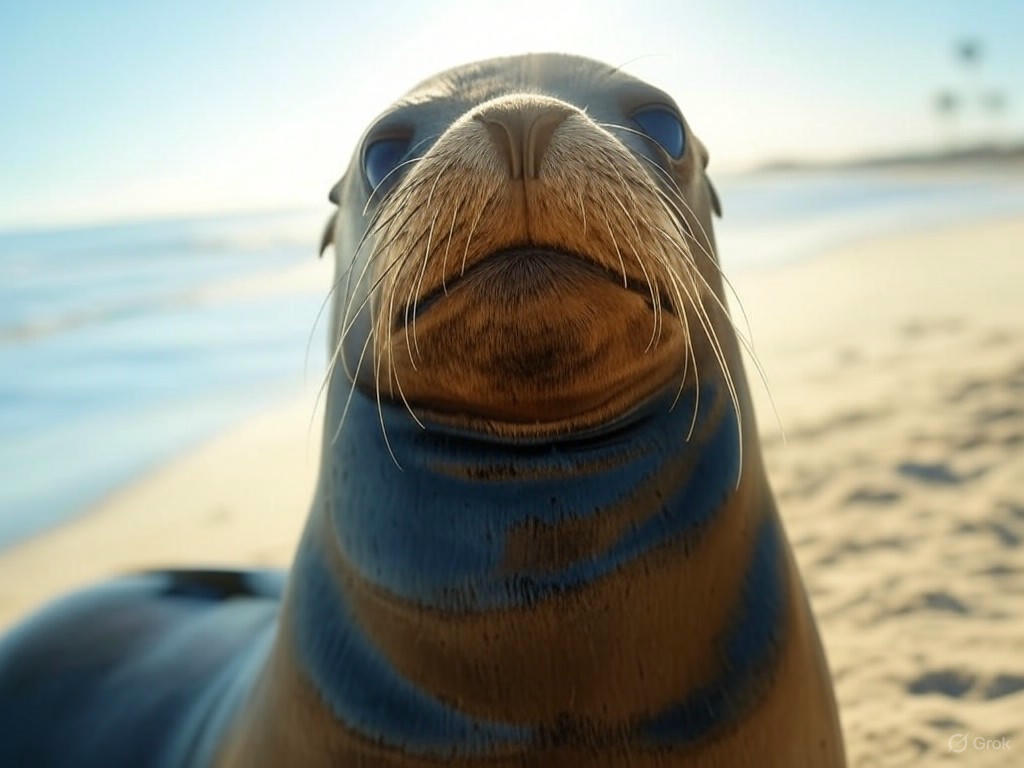
Sea Lion Surprises Scientists by Bobbing to Music
Meet Ronan: The Sea Lion Who Dances Better Than You
Ronan the sea lion has become a surprising star in the world of animal behavior, showing off rhythm skills that make you question what we know about musicality in nature. At 15 years old, this California sea lion effortlessly bobs her head to beats, even nailing disco classics like “Boogie Wonderland” with stunning accuracy.
Imagine a sea lion grooving better than many of us at a party—it’s not just fun; it’s groundbreaking. Peter Cook, a behavioral neuroscientist at New College of Florida, has spent a decade studying Ronan the sea lion, and he can’t hide his excitement: “She just nails that one,” referring to her precise head sways that adapt to tempo changes.
What makes Ronan the sea lion’s abilities so fascinating is how they’ve challenged the idea that keeping a beat is a human-only trait. Along with a few other animals, like Snowball the dancing cockatoo, she’s proving that rhythm perception might be more widespread. Have you ever wondered if your pet could jam to your favorite tunes? Ronan’s story might just make you pay closer attention.
Breaking Records in Beat-Keeping Precision
Recent studies on Ronan the sea lion reveal her rhythm has not only held steady but improved over time, turning her into a benchmark for animal musicality. She hits beats with precision down to 15 milliseconds, which is about ten times faster than the average human eye blink at 150 milliseconds.
Cook is unequivocal: “No other non-human animal is as precise and consistent as Ronan is.” What’s truly remarkable is how she started off less accurate and honed her skills through practice. In fact, when researchers compared her to human participants, including college students from UC Santa Cruz, Ronan the sea lion outperformed them at every tempo—even unfamiliar ones.
This level of beat keeping raises intriguing questions: Could Ronan the sea lion be unlocking secrets about how animals process music? Her consistency is a game-changer in rhythm perception studies, showing that with the right training, non-human species might rival or exceed us in certain cognitive tasks.
Exploring Ronan the Sea Lion’s Superior Synchronization
Dive deeper into Ronan the sea lion’s synchronization, and you’ll see why scientists are buzzing. In controlled tests, she adapted to new tempos without missing a beat, a feat that highlights her advanced rhythmic entrainment.
Think about it: If a sea lion can keep time better than college students, what does that say about our assumptions on learning and music? This superior synchronization isn’t just impressive; it’s reshaping comparative neuroscience by showing how animals might share more cognitive traits with us than we realized.
From Highway Rescue to Scientific Sensation
Ronan the sea lion’s story began in 2009, when she was found stranded and malnourished along California’s Highway 1, leading to her permanent home at the Pinniped Lab at UC Santa Cruz. Unable to return to the wild, she transformed from a rescue case into a pioneer in animal studies.
By 2013, Ronan the sea lion had already made history as the first non-human mammal to show rhythmic entrainment, syncing movements to an external beat. A decade later, follow-up tests confirmed her skills hadn’t faded—they’d sharpened, defying expectations and sparking fresh interest in animal musicality.
Her journey is a reminder of how unexpected events can lead to major discoveries. What if more rescued animals held hidden talents like Ronan the sea lion? This narrative not only captivates but also encourages us to look beyond surface appearances in the animal kingdom.
Putting Ronan to the Scientific Test
To truly test Ronan the sea lion’s capabilities, researchers designed challenges that pushed her limits, like syncing her head bobs to a metronome at tempos of 112, 120, and 128 beats per minute, with only one being familiar. She rose to the occasion, maintaining incredible accuracy.
Humans in the study were asked to move their forearms in time, a fair parallel to Ronan the sea lion’s head movements, as Cook noted. The results? Her variability was just a fraction of an eyeblink, with hits landing within milliseconds of the beat—sometimes early, sometimes late, but always spot-on.
This testing process underscores the depth of rhythm perception in animals. If Ronan the sea lion can adapt so seamlessly, it might inspire new ways to study cognition in marine life. Ever tried keeping beat to a fast song? It’s humbling to think she does it with ease.
The Edge in Ronan the Sea Lion’s Rhythm Perception
What sets Ronan the sea lion apart in rhythm perception is her ability to learn without relying on vocal skills, challenging old theories about musical entrainment. Unlike parrots or primates, she syncs purely through movement.
This edge in rhythm perception has earned her praise from experts like Henkjan Honing at the University of Amsterdam, calling her a “top ambassador” for animal musicality. It’s a subtle yet powerful distinction that could redefine how we approach comparative studies.
What Makes Ronan’s Abilities So Special?
Ronan the sea lion stands out because she can groove to a beat independently of vocal learning, upending notions that tied rhythm to speech-like abilities. This uniqueness is key to understanding broader patterns in animal cognition.
While humans often anticipate beats slightly ahead, Ronan the sea lion adjusts based on tempo—drifting ahead at slower speeds and lagging at faster ones—yet still achieves superior precision. Her story invites us to explore: How might these traits evolve, and what can we learn from them?
Experts hail Ronan the sea lion as a standout in beat keeping, offering insights into why some species excel in musical tasks. This isn’t just about one sea lion; it’s about uncovering shared evolutionary threads in rhythm across animals.
The Future of Animal Musicality Research
Buoyed by Ronan the sea lion’s feats, scientists are now eyeing tests with other sea lions to see if her talents are widespread or exceptional. Cook believes she might remain a leader, but the potential for discovery is vast.
Future plans include live performances with musicians, though they’d need breaks for fish to keep things engaging. This blend of fun and science could open doors to more interactive studies in animal musicality, making research feel less clinical and more dynamic.
Have you considered how music affects animals in your daily life? Ronan the sea lion’s influence might encourage us to experiment with rhythms around our pets, fostering a deeper appreciation for cross-species connections.
Challenging Our Understanding of Music and Cognition
Ronan the sea lion’s prowess is prompting a rethink of music perception, suggesting that rhythmic entrainment isn’t exclusively human. This shift is invigorating fields like comparative neuroscience, where shared neural mechanisms might be at play.
Her performances highlight evolutionary questions: Did rhythm develop as a social tool, and how does it appear in diverse species? By studying Ronan the sea lion, researchers are pioneering novel approaches outside traditional labs, blending ecology with cognition.
This work emphasizes the need for innovative methods, as Cook advocates, to explore brain and behavior in real-world contexts. It’s a call to action for more inclusive science that could reveal surprising overlaps in how animals—and humans—experience music.
The Broader Implications
Beyond labs, Ronan the sea lion’s story sparks public wonder about marine mammal intelligence, showing how cognitive abilities can thrive in unexpected places. At the Long Marine Laboratory, she continues to wow visitors with her rhythmic displays.
Her tale reminds us that animals often hold untapped potentials. For instance, imagine if conservation efforts incorporated music-based enrichment—could it enhance animal well-being, as seen with Ronan the sea lion? This approach might offer practical strategies for zoos and wildlife centers.
Engaging with these ideas could transform how we interact with nature, promoting empathy and awareness through simple, enjoyable activities.
Conclusion
Ronan the sea lion has redefined animal musicality, proving that rhythm keeping is more than a human specialty. Her evolution from a rescued individual to a scientific icon illustrates the wonders hiding in the natural world.
As researchers delve deeper, including potential collaborations with live bands, we’re reminded of the joy in these discoveries. What do you think—could Ronan the sea lion inspire your next playlist? Share your thoughts in the comments, explore more on animal cognition in our related posts, or subscribe for updates on groundbreaking science.
References
1. A study from ABC News highlights Ronan’s rhythmic abilities: Scientists Thought Only Humans Could Bob to Music—Then Came Ronan the Sea Lion.
2. Insights from Science Focus on her precision: Sea Lion’s Beat-Keeping Amazes Scientists.
3. ZME Science details her tests and implications: Ronan the Sea Lion and Beat Synchronization.
Additional sources consulted include a YouTube video on the topic: Ronan in Action, and various research compilations.
Ronan sea lion, animal musicality, rhythm perception, beat keeping, comparative neuroscience, sea lion rhythm, animal cognition, musical entrainment, wildlife research, cognitive abilities







